
Researching Canadian Soldiers of the First World War
Part 12: Medals; Pip, Squeak, Wilfred and the whole gang
By Michael O'Leary; The Regimental Rogue
Introduction
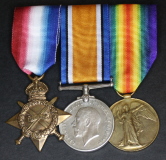
If you ask four collectors and researchers the definition of a medal group, you will end up with at least five explanations. In simplistic terms with regard to First World War medals, the term "group" is usually used to refer to all of a soldier's medals taken together, and comprised of his "pair" or "trio" plus other medals.
Many visitors to these pages will have been prompted to learn more about an ancestor's service in the First World War with the Canadian Expeditionary Force because of medals. Those medals might still be with the family; either kept as treasured heirlooms or recently found deep in a drawer or trunk, or they may be long gone from the family; lost, sold or (more rarely) stolen and adrift in the wide wide world. So often tales are seen of rediscovered medals, previously unknown to the family members who have found them, resting deep in an old trunk, carefully placed in a commemorative biscuit tin or other receptacle, perhaps still mounted as the returned soldier wore then, or sometimes still in the small boxes in which they were received, and never worn.
Of those many medals that have left the original families, most did so under honourable circumstances; from being sold in house auctions at the death of the last of the family line that held them, or sold during hard times to feed hungry children (an apocryphal anecdote usually applied to a missing silver British War Medal, or one that has been found separated from its fellows). Some were sold by their recipient for whom they brought only memories of death and suffering, because Post-Traumatic Syndrome Disorder (PTSD) is by no means a modern affliction, or as it was known in the Great War era: "Shell Shock". But all is not lost, with luck and perseverance some of those wandering medals find their way back to the original families, usually with gratitude expressed toward the last of a line of collectors who preserved their heritage and treated their relationship to the medals as custodians of a soldier's story. Think not poorly of those collectors who spend time, money and effort to care for medals in their collections, often researching the men they belonged to and learning their stories. No man spends hundred or thousands of dollars on medals as an act to "dishonour" soldiers and if these medals had not been preserved by so many collectors, they would have disappeared long ago as one more "old thing" lacking any value in society.
For a new researcher (or an old one), whether family or regimental, to hold a soldier's medals in ones hand is to touch a physical artifact of his service. Even though they were issued after the fact, sometimes years after the close of the soldier's service record, medals remain a tangible link to that past and concrete evidence of the steps he took in heavy boots in service to his nation.
But where to begin? I suppose we should start by looking in the biscuit tin.
Note: Linked medal names will lead to pages at the Veterans Affairs Canada site which will provide descriptions and details of eligibility for each medal.
So, What's in the Biscuit Tin?
"Pip, Squeak and Wilfred"
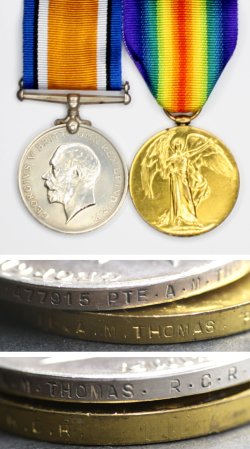
The British War Medal and Victory Medal "pair" awarded to 477915 Private Albert Morley Thomas of The Royal Canadian Regiment.
Since we're mainly focused on researching a soldier of the First World War, we'll start with what's most likely in the tin. There's probably two medals at least, a silver one and a gold coloured one. Each might have an attached ribbon, the silver medal's ribbon would be mainly orange with blue edges and the gold medal would have a rainbow striped ribbon, red in the centre and purple on the edges. These two, the most common issued to soldiers of the Canadian Expeditionary Force are the British War Medal and the Victory Medal. If there is a third medal, a star-shaped one, it will probably be the 1914-1915 Star. We'll address these three before we move on to other, less common medals that may also be in the tin.
The 1914-1915 Star, the British War Medal and the Victory Medal are the most common medal issued to Canadian soldiers in the Great War. The latter two are the more common of the three, because to receive the 1914-15 Star required the soldier to have reached the front lines before 31 December 1915. Because of this, soldiers who enlisted later in the war received only the latter two.
For each medal, check the back of the star and the lower edge of the discs for the soldier's service number, name and unit impressed (i.e., die-struck, not engraved) into the metal.
Special Cases
Because nothing is simple, even with the purported regimentation of military bureaucracy, even these three basic medals are subject to special cases. I shall not dwell on such details, but it is helpful to identify that unique cases exist:
- A small number of Canadians received the 1914 Star instead of the 1914-15 Star, this was for those who arrived in France before 23/23 Nov 1914. It is estimated that fewer than 200 went to Canadians.
- Some soldiers received only the British War Medal and did not receive the Victory Medal. This occurred when the soldier served overseas in England but did not reach France or Flanders on the nominal roll of a front-line unit before the Armistice on 11 Nov 1918.
Those three medals, the 1914-1915 Star, the British War Medal and the Victory Medal are sometimes referred to as "Pip, Squeak and Wilfred", a soldier's nickname for them, after the characters in a British newspaper cartoon strip (which was published starting in 1919).
The Other Medals you Might Find
Let's look at the possible components of an officer's or soldier's medal group, which, depending on length of service and specific activities, could include any of the following:
- Orders and Decorations for Valour or Service, for example, Victoria Cross, Distinguished Service Order, Military Cross, Distinguished Conduct Medal, Military Medal, etc. If you've found one of these in your biscuit tin, see Part 6: Researching Honours and Awards.
- Pre-1914 Campaign Medals; if your soldier served in the military before the First World War, he may have received medals from campaigns before 1914. This is more likely if he had previous service with the British Army.
- 1914 or 1914-15 Star
- British War Medal
- Victory Medal
- Post 1918 Campaign Medals; if your soldier continued to serve in the military after the First World War, he may have received medals from campaigns after 1918. This is more likely if he served with the British Army.
- Commemorative Medals: some soldiers who served after the war were members of Coronation detachments or received commemorative medals for other reasons.
- Efficiency Long Service and Good Conduct Medals
- Foreign Awards. Some soldiers of the Canadian Expeditionary Force received foreign awards. These may include the French or Belgian Croix de Guerre, Russian Orders of St George, or others. These foreign awards are normally mounted to the right of the soldier's other medals (i.e., to the right as you view the medals as they might be worn).
Depending on what other medals (if any) you have with the soldier's First World War service medals, if any, will determine what other particulars of service you may need to investigate. For any that were also awarded during the Great War, your best starting point remains the soldier's service record. For Honours and Awards, you will find some additional research guidance at this page
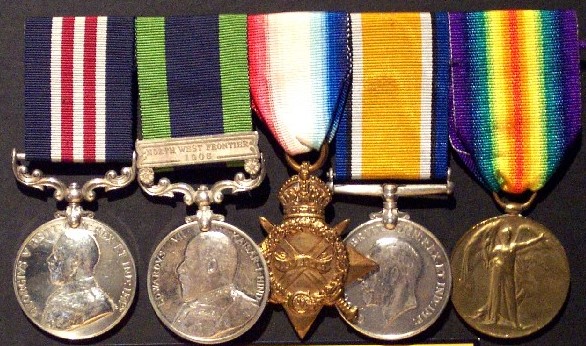
The First World War Medal group awarded to 477781 Corporal Arthur Rix of The Royal Canadian Regiment. Rix's medal group consists of the Military Medal (for bravery in the field), the India General Service Medal (for pre-War service in the British Army) the 1914-1915 Star, the British War Medal and the Victory Medal.
Terminology
Before we go on, let's examine some basic medal terminology. Understanding these terms will help when you go one to explore Great War or Medal Forums, such as Canadian Expeditionary Force Study Group, the Great War Forum and the British Medal Forum for more information.
Group - If you ask four collectors and researchers the definition of a medal group, you will end up with at least five explanations. In simplistic terms with regard to First World War medals, the term "group" is usually used to refer to all of a soldier's medals taken together, and comprised of his "pair" or "trio" plus other medals.
Trio - Pip, Squeak and Wilfred - the basic trio of First World War medals; the 1914-1915 Star, the British War Medal and the Victory Medal. The term "trio" refers to these three, while other combinations of three would be a described as a "group."
Pair - The British War Medal and the Victory Medal, the standard pair of medals issued to soldiers who served at the front but did not arrive early enough for a "Star."
Single - The only First World War medal of the trio that was issued alone is the British War Medal, and if this is a soldier's full entitlement it could (irreverently) be called his group (to the consternation of the pedants among collectors). A "single" may also refer to an individual medal which has become separated from its pair, trio or group. Many soldiers' medals were divided among family as individual mementos.
Broken Group - A broken group refers to any part of a soldier's full entitlement, from a separated single to any but his full entitlement of medals.
Bar - Bars, signifying second awards, were worn on the ribbons of decorations (i.e, valour awards). To state that a man was "MM and bar" is to say that he was awarded the Military medal twice during his service.
MiD - MiD, or "Mention in Despatches"; soldiers who actions were brought to the attention of the King by their commanders, but not sufficiently significant to be recommended for a decoration might be awarded a Mention in Despatches. The recipient of one (or more) MiDs was entitled to wear a small oak leaf emblem on the ribbon of the Victory Medal (or the British War Medal if the Victory Medal was not awarded).
Swing Mounted - A manner of mounting medals for wear used at the time of the First World War, in which each medal swings freely below a hanging bar.
Court Mounted - A style of mounting medals in which each medal and ribbon is fixed to a rigid backing. Most modern medal mounters, who may remount your medals for display, will be more experienced in this technique. Some state that it is a more presentable design, and that the manner of fixing each medal in place eliminates the possibility of damage by the knocking edges of adjacent medals.
Memorial Items sent to Casualties' Next-of-Kin
During the First World War the families of soldiers who died as result of their service (killed in action, died of wounds, injury, sickness or accident) received memorial items in addition to the soldiers' entitlement of medals. For medallic items, these consisted of the Memorial Cross and the Memorial Plaque. Certain collectors consider a casualty's medal group to be "complete" only if issued Memorial Cross(es) and Plaque are kept with the medals.
Memorial Cross
The Memorial Cross was fashioned of sterling silver and impressed on the reverse with the soldier's service number, rank, name and (if any) post-nominals designating received honours. Crosses were sent to a deceased soldier's mother (if she was still alive) and to his wife (if he was married). Based on this there may be one, two or no Memorial Crosses awarded for any particular casualty.
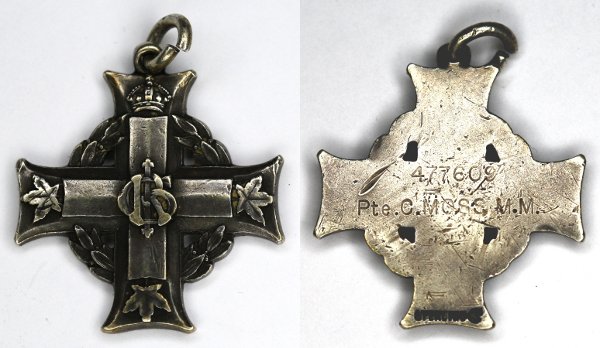
The Memorial Cross sent to the next-of-kin of 477609 Private Clifford Moss, M.M. of The Royal Canadian Regiment.
Memorial Plaque
The Memorial Plaque was fashioned of bronze, about 5 inches (120 mm) in diameter and cast with the soldiers name as part of the face of the plaque. The plaque was sent to the soldier's next-of-kin, regardless of whether or not Memorial Crosses were issued.
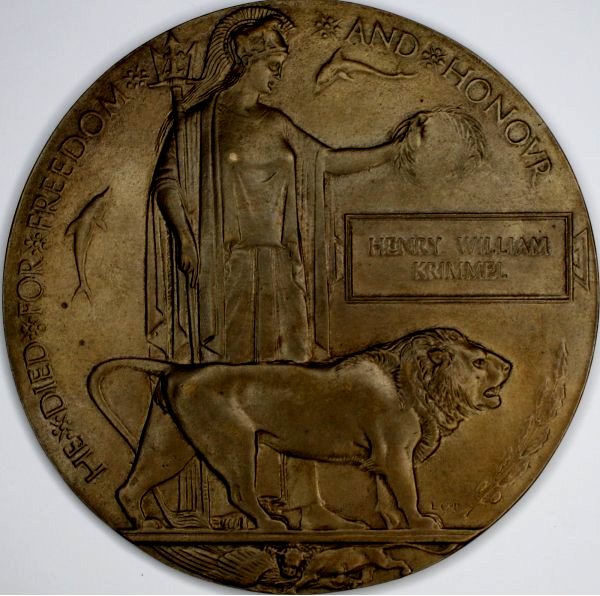
The Memorial Cross sent to the next-of-kin of 477501 Private Henry William Krimmell, a soldier of of The Royal Canadian Regiment who died accidentally while serving with the 7th Canadian Light Trench Mortar Battery.
Medal Card
The CEF soldier's service record will normally include a copy of his medal card. Though cryptic, this card will show what medals and memorial items were awarded. Commonly, the issue of the Britsh War Medal and Victory Medal are shown on these cards by a large hand-written "B" and "V", each with a check-mark through them.
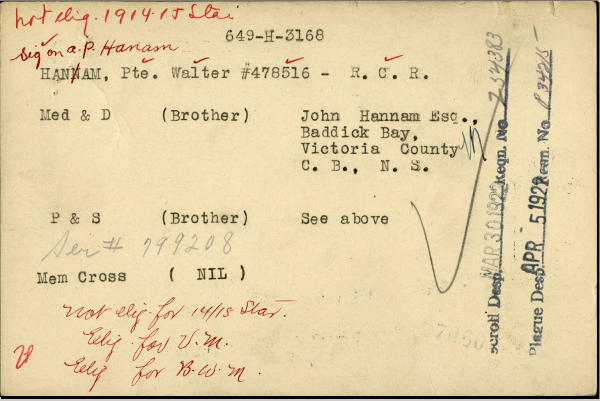
The medal card in the service record of 478516 Private Walter Hanam. Note that Hanam was not eligible for the 1914-15 Star but was awarded the Victory Medal and the British War Medal. For memorial items, no Memorial Cross was issued (unmarried and mother likely predeceased), a Memorial Plaque was despatched on 30 March 1922 a Memorial Scroll followed on 5 April 1922.
War Service Badges
Depending on the nature of his service, a soldier would receive a War Service Badge on leaving the Army. This could be worn on his civilian jacket lapel to show others, such as potential employers, that he was a returned soldier.
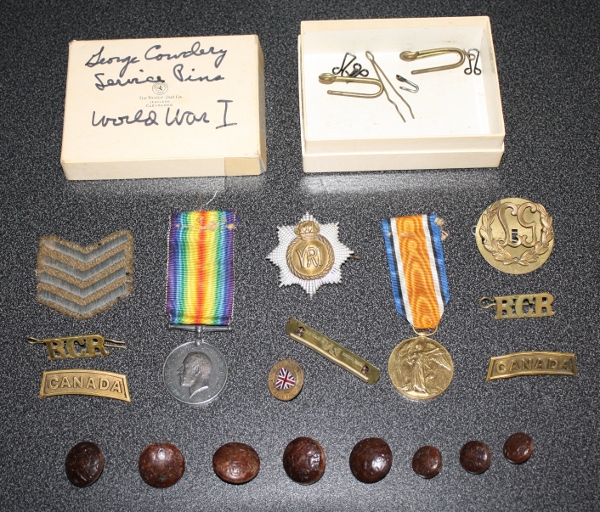
The contents of the small box that contained 739068 Private George Cowdery's medals and associated items. Included are Cpl Cowdery's British War Medal and Victory Medal (with reversed ribbons), his stripes denoting four years of wartime service, regimental cap badge for The Royal Canadian Regiment, Lewis Gunner trade badge, "R.C.R. shoulder titles, "Canada" shoulder titles, wound stripe and his War Service badge. Also found in the box were the buttons and belt hooks from his great coat.
So, what's in the biscuit tin you're holding?
Researching Canadian Soldiers of the First World War
- Introduction
- Part 1: Find your Man (or Woman)
- Part 2: The Service Record
- Part 3: Court Martial Records
- Part 4: War Diaries and Unit Histories
- Part 5: Casualties
- Part 6: Researching Honours and Awards
- Part 7: Deciphering Battlefield Location Information
- Part 8: More Mapping Information
- Part 9: Matching Battlefield Locations to the Modern Map
- Part 10: Service Numbers; More than meets the eye
- Part 11: Rank, no simple progression
- Part 12: Medals; Pip, Squeak, Wilfred and the whole gang
- Part 13: Evacuation to Hospital
- Part 14: The Wounded and Sick
- Part 15: Crime …
- Part 16: … and Punishment
- Part 17: Battalions and Brigades, Companies and Corps
- Part 18: Photo Forensics: Badges and Patches
- Part 19: Veterans Death Cards
- Part 20: The Vimy Pilgrims (1936)

- The O'Leary Collection; Medals of The Royal Canadian Regiment.
- Researching Canadian Soldiers of the First World War
- Researching The Royal Canadian Regiment
- The RCR in the First World War
- Badges of The RCR
- The Senior Subaltern
- The Minute Book
- Rogue Papers
- Tactical Primers
- The Regimental Library
- Battle Honours
- Perpetuation of the CEF
- A Miscellany
- Quotes
- The Frontenac Times
- Site Map
QUICK LINKS
- Tomb of the Unknown Soldier
- Vimy Memorial
- Dieppe Cemetery
- Perpetuation of CEF Units
- Researching Military Records
- Recommended Reading
- The Frontenac Times
- RCR Cap Badge (unique)
- Boer War Battles
- In Praise of Infantry
- Naval Toast of the Day
- Toasts in the Army (1956)
- Duties of the CSM and CQMS (1942)
- The "Man-in-the-Dark" Theory of Infantry Tactics and the "Expanding Torrent" System of Attack
- The Soldier's Pillar of Fire by Night; The Need for a Framework of Tactics (1921)
- Section Leading; A Guide for the Training of Non-Commissioned Officers as Commanders and Rifle Sections, 1928 (PDF)
- The Training of the Infantry Soldier (1929)
- Modern Infantry Discipline (1934)
- A Defence of Close-Order Drill (1934): A Reply To "Modern Infantry Discipline"
- Tactical Training in the British Army (1901)
- The Promotion and Examination of Army Officers (1903)
- Discipline and Personality (1925)
- The Necessity of Cultivating Brigade Spirit in Peace Time (1927)
- The Human Element In War (1927)
- The Human Element In Tanks (1927)
- Morale And Leadership (1929)
- The Sergeant-Major (1929)
- The Essence Of War (1930)
- Looks or Use? (1931)
- The Colours (1932)
- Personality in Leadership (1934)
- Origins of Some Military Terms (1935)
- Practical Examination; Promotion to Colonel N.P.A.M. (1936)
- Company Training (1937)
- Lament Of A Colonel's Lady (1938)
- Morale (1950)
- War Diaries—Good, Bad and Indifferent
- Catchwords – The Curse and the Cure (1953)
- Duelling in the Army
- Exercise DASH, A Jump Story (1954)
- The Man Who Wore Three Hats—DOUBLE ROLE
- Some Notes on Military Swords
- The Old Defence Quarterly (1960)
- Military History For All (1962)
- Notes for Visiting Generals (1963)
- Hints to General Staff Officers (1964)
- Notes for Young TEWTISTS (1966)
- THE P.B.I. (1970)
- Standing Orders for Army Brides (1973)
- The Time Safety Factor (1978)
- Raids (1933)
- Ludendorff on Clerking (1917)
- Pigeons in the Great War
- Canadian Officer Training Syllabus (1917)
- The Tragedy of the Last Bay (1927)
- The Trench Magazine (1928)
- Billets and Batman (1933)
- Some Notes on Shell Shock (1935)
- Wasted Time in Regimental Soldiering (1936)
- THE REGIMENT (1946)
- The Case for the Regimental System (1951)
- Regimental Tradition in the Infantry (1951)
- The Winter Clothing of British Troops in Canada, 1848-1849
- Notes On The Canadian Militia (1886)
- Re-Armament in the Dominions - Canada (1939)
- The Complete Kit of the Infantry Officer (1901)
- The Canadian Militia System (1901)
- The Infantry Militia Officer of To-day and His Problems (1926)
- Personality in Leadership (1934)
- British Regular Army in Canada
- Battle Honours (1957)
- Defence: The Great Canadian Fairy Tale (1972)
- The Pig (1986)
- Standing Orders for the Fortress of Halifax, N.S.; 1908
- Medals and Badges - Fakes and Copies
- Army Punishments Part 1 - • Part 2
• C.A.R.O. No. 6719 - Campaign Stars, Clasps, The Defence Medal and the War Medal 1939-45
[an error occurred while processing this directive]
[an error occurred while processing this directive]
[an error occurred while processing this directive]